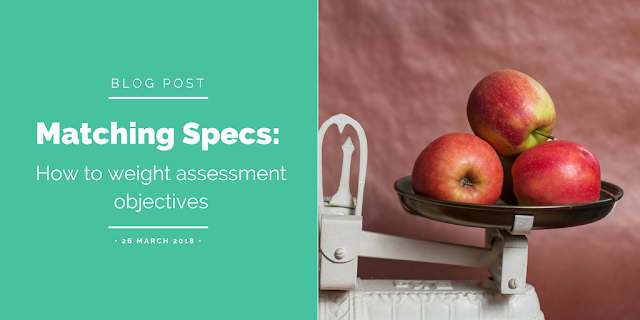New Feature: Tracker
So, a few weeks ago I hinted in this post at some brand new features that come out of the ability to set up assessments for multiple classes at once. Well, here's one for you!
This feature is available to teachers and administrators who belong to a department or school SmartRubric account (Sorry, solo teachers! You can upgrade for as little as 10 GBP/month).
The Departmental Spreadsheet will be a familiar beast to most of you, and, to be completely honest, it isn't something that SmartRubric has been able to replace...until now.
Now that you can create linked assessments for a bunch of classes at once (this post tells you how), you are probably going to want to look at a nice, friendly, top level overview of how all of the students are doing on these linked assessments. You probably want something that looks like this:
Just imagine the efficiency. You, as department administrator, can set up all of your formal assessments for the whole year (if you want!), make a tracker like the one above and then share it with your beloved colleagues (it has a permalink).
Want to know why this is better than your old departmental spreadsheet? Here are some reasons:
Don't worry -- if you (like me) want to be able to do more with your data, if your heart skips a beat at a beautifully rendered table with helpful conditional formatting, you can download your tracker with the click of a button and open it in MS Excel, or OpenOffice, or Numbers or Google Sheets and do whatever you want with it.
Excited yet? Here's how you make one:
I'm going to pretend that I'm a KS4 coordinator in an English department. There are four sets, and I want to set up a number of mock exams for all of them.
First, I'll create my four mock exams. You do this by following the instructions in this post. Briefly, you click the button on the dashboard that says 'New Multiple-Class Assessment', then name it something sensible like 'Paper 1 October Mock', pick a rubric, select the classes you wish to take this assessment, and scheduling it:
I'll do this four times, and schedule four practice papers -- one per half term up until Easter. My assessment list will look like this when I'm done:
 When I'm happy with how the tracker looks, I'll bookmark it. The URL of the tracker (soz it's so ugly) is a permalink, which means that I can share it with your colleagues (this is a good time to try out the 'Messages' feature, which you'll find under your account menu).
When I'm happy with how the tracker looks, I'll bookmark it. The URL of the tracker (soz it's so ugly) is a permalink, which means that I can share it with your colleagues (this is a good time to try out the 'Messages' feature, which you'll find under your account menu).
Right now, there isn't much in there, because none of my students have target grades and the assessments are all un-marked. But, as these things are added, your tracker will automatically update.
Here's what my tracker looks like with a bit more content:
This feature is available to teachers and administrators who belong to a department or school SmartRubric account (Sorry, solo teachers! You can upgrade for as little as 10 GBP/month).
The Departmental Spreadsheet will be a familiar beast to most of you, and, to be completely honest, it isn't something that SmartRubric has been able to replace...until now.
Now that you can create linked assessments for a bunch of classes at once (this post tells you how), you are probably going to want to look at a nice, friendly, top level overview of how all of the students are doing on these linked assessments. You probably want something that looks like this:
 |
Want to know why this is better than your old departmental spreadsheet? Here are some reasons:
- It's interactive: Want to know why little Arlo bombed question 2 on the second mock of the season? Just click on his score and be taken right into the rubric. Still not satisfied? Click on his group and get an up to date progress report for that class.
- It's real time: No more chasing teachers to fill in the d*mn spreadsheet. As soon as they use SmartRubric to mark, the grades appear as if by magic, in the tracker.
- It remembers: If you're evaluating students against a rubric that they've been marked against before (even if it wasn't for a shared assessment), you'll get a little up, down or right caret icon next to the grade that will give you a quick indication of whether the student has made progress, slid backwards, or stayed the same gradewise.
- Version control: Spreadsheets are lovely. I adore Excel and I think more people should too. But. How many times have you saved a departmental spreadsheet to the common drive, and ended up with an enormous proliferation of copies with names like 'Year 11 - Set B added' or 'Year 11 - MJB sorry this is so late'? Google sheets solves the version control problem but has other drawbacks. Version control is a non-issue with the SmartRubric tracker.
- Flags for moderation/editing: If a grade has been changed manually, the letter '(e)' will appear after the grade. Click in to see the original, calculated mark. If the grade has been moderated, you'll get an '(m)'.
Don't worry -- if you (like me) want to be able to do more with your data, if your heart skips a beat at a beautifully rendered table with helpful conditional formatting, you can download your tracker with the click of a button and open it in MS Excel, or OpenOffice, or Numbers or Google Sheets and do whatever you want with it.
Excited yet? Here's how you make one:
I'm going to pretend that I'm a KS4 coordinator in an English department. There are four sets, and I want to set up a number of mock exams for all of them.
First, I'll create my four mock exams. You do this by following the instructions in this post. Briefly, you click the button on the dashboard that says 'New Multiple-Class Assessment', then name it something sensible like 'Paper 1 October Mock', pick a rubric, select the classes you wish to take this assessment, and scheduling it:
 |
| Like so. |
I'll do this four times, and schedule four practice papers -- one per half term up until Easter. My assessment list will look like this when I'm done:
The teachers responsible for each of these classes will see them appear in their Recent Assessments list.
Now, I'll make the tracker. Go to Admin -> Tracker (if it doesn't appear, it means you are a solo teacher and don't have access to this feature - sorry! You can upgrade easily here).
Now you'll have the option to select the classes you wish to track.
As you select classes, you will get a list of available assessment. If you select more than one class, all of the assessments in the list must have been created using the 'New Multiple-Class Assessment' button or menu item (Assessments -> New multiple class assessment).
Pick the assessments you want. As you choose assessments, you'll notice that the rubrics for those selected assessments will appear in the third step of the wizard:
This is a fun (optional) feature that let's you 'borrow' the grade boundaries from a relevant rubric so that the tracker can calculate predicted grades for your students. In this case, since the grade boundaries for all four of my papers are the same, it doesn't matter which one I pick. When I'm done, I click 'Submit'.
 |
| Ta dah! |
 When I'm happy with how the tracker looks, I'll bookmark it. The URL of the tracker (soz it's so ugly) is a permalink, which means that I can share it with your colleagues (this is a good time to try out the 'Messages' feature, which you'll find under your account menu).
When I'm happy with how the tracker looks, I'll bookmark it. The URL of the tracker (soz it's so ugly) is a permalink, which means that I can share it with your colleagues (this is a good time to try out the 'Messages' feature, which you'll find under your account menu).Right now, there isn't much in there, because none of my students have target grades and the assessments are all un-marked. But, as these things are added, your tracker will automatically update.
Here's what my tracker looks like with a bit more content:
As with most of the other tables in SmartRubric, you can sort and filter the tracker by clicking on the column headers or using the search bar above it. You can also export to Excel or CSV (or just copy the data to the clipboard) by using the buttons above it.
That's it! I hope this makes your teaching life easier and more streamlined.








Comments
Post a Comment